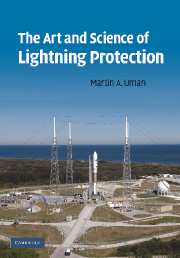Book contents
- Frontmatter
- Contents
- Preface
- 1 What is lightning?
- 2 Lightning damage
- 3 General methods for lightning protection: Faraday cages, topological shields; and more practical approaches: cone of protection and rolling sphere methods
- 4 Structure protection: air terminals and down conductors
- 5 Structure protection: grounding
- 6 Surge protection for electronics in low-voltage electrical systems
- 7 Humans and animals
- 8 Lightning warning
- 9 Airships, airplanes, and launch vehicles
- 10 Ships and boats
- 11 Trees
- 12 Overhead and underground power and communication lines
- 13 Lightning elimination
- 14 So, what do we know and what don't we know about lightning protection?
- Index
- References
9 - Airships, airplanes, and launch vehicles
Published online by Cambridge University Press: 17 November 2009
- Frontmatter
- Contents
- Preface
- 1 What is lightning?
- 2 Lightning damage
- 3 General methods for lightning protection: Faraday cages, topological shields; and more practical approaches: cone of protection and rolling sphere methods
- 4 Structure protection: air terminals and down conductors
- 5 Structure protection: grounding
- 6 Surge protection for electronics in low-voltage electrical systems
- 7 Humans and animals
- 8 Lightning warning
- 9 Airships, airplanes, and launch vehicles
- 10 Ships and boats
- 11 Trees
- 12 Overhead and underground power and communication lines
- 13 Lightning elimination
- 14 So, what do we know and what don't we know about lightning protection?
- Index
- References
Summary
Overview
The metal skin of a modern airplane can be considered a good approximation both to a Faraday cage and to the outer surface of a topological shielded system (see Section 3.1). As such, the skin provides the primary lightning protection for the aircraft. Generally, when lightning strikes a metal airplane, the lightning current remains in the skin of the plane as it flows between entrance and exit points. If the shielding by the plane's skin were perfect, there would be no danger to the interior electronics or to the fuel in the wings of the airplane. Unfortunately, there are openings (apertures) such as windows in the metal skin and antennas that project through insulated areas in the skin, both of which may serve as entry points for lightning electromagnetic fields. Additionally, the plane's aluminum skin is not always thick enough to avoid direct damage by a severe lightning charge flowing into the skin (see Section 2.3). Lightning often disables interior aircraft electronics, as we shall discuss in Section 9.2, and occasionally lightning can burn through the aircraft's skin, igniting fuel or releasing hydraulic fluids, examples of which are given in Section 9.3. In Section 9.4, we will briefly consider the standards for testing aircraft to make more certain they can withstand a lightning strike without serious consequences.
Contrary to the common view, most lightning discharges that strike airplanes in flight are initiated by the planes themselves. The lightning would not have occurred if the plane had not been present.
Information
- Type
- Chapter
- Information
- The Art and Science of Lightning Protection , pp. 152 - 174Publisher: Cambridge University PressPrint publication year: 2008
